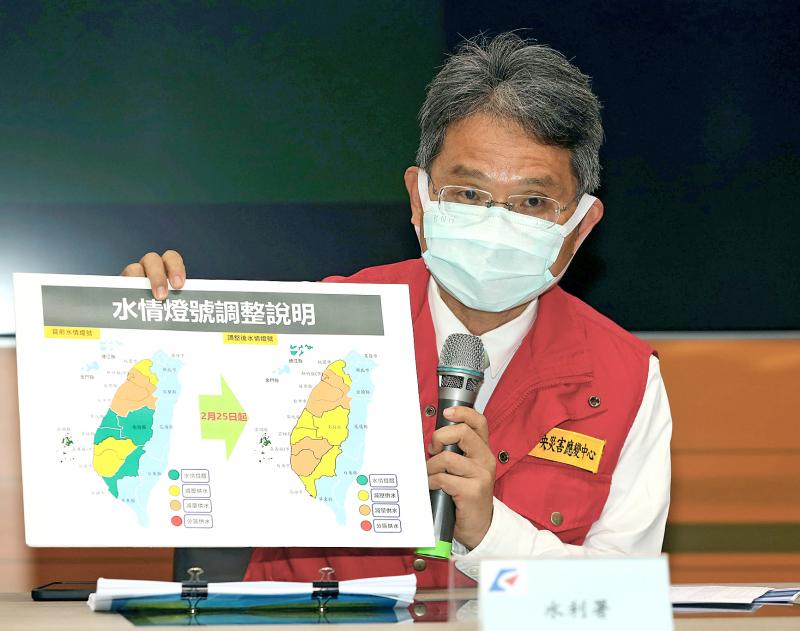A water shortage in Taiwan has worsened, necessitating further restrictions, the Ministry of Economic Affairs said yesterday.
“While we have had a little rain over the Lunar New Year break, it did not help substantively with water reserves,” Minister of Economic Affairs Wang Mei-hua (王美花) told a news conference in Taipei. “We are facing an even more serious situation.”
Twenty to 40mm of rain fell over the holiday, not enough to significantly affect the nation’s dwindling water reserves, Wang said.

Photo: CNA
It has been a historically difficult dry season in Taiwan, with no typhoons making landfall during last year’s wet season to fill reservoirs, the ministry said.
The dry season does not end until May, it said.
The Central Weather Bureau has predicted this month and next month to be “drier than usual,” Wang said.
While the eastern part of Taiwan is not facing shortages, almost every area in the nation’s west is under some level of water restriction, she said.
After an interdepartmental meeting to discuss the situation, Tainan and Chiayi County on Thursday next week would be placed on an orange alert, up from a yellow alert, Water Resources Agency Director-General Lai Chien-hsin (賴建信) said.
Kaohsiung, and Changhua, Yunlin and Nantou counties would be placed on a yellow alert on the same day, although Taichung, and Hsinchu and Miaoli counties would remain on an orange alert, and Taoyuan on a yellow alert, Lai said.
The agency’s system states that areas under a yellow alert have water pressure reduced during off-peak hours, while the government would conserve water by delaying landscaping irrigation and exterior washing of public facilities.
An orange alert entails limiting total water use, as well as reducing water pressure.
Industrial water use in Hsinchu, Miaoli and Taichung would be cut by 11 percent, from 6 percent, the agency said.
Industrial water users in Tainan and Chiayi are to cut use by 7 percent, while non-industrial entities that use large volumes would cut usage by 10 percent, it said.
“We will be monitoring water meters to see if the standards are being adhered to,” Lai said. “If companies fail to comply after an encouragement, they would have their water supply cut off.”
With the exception of the third irrigation zone in Taoyuan, irrigation has been halted across Taiwan, Wang said.
As there is still “great uncertainty” over whether the situation would worsen, Wang called on the central and local governments, as well as the public, to conserve water as much as possible.
The government has mobilized emergency water resources, such as an emergency desalination plant in Hsinchu County and emergency wells, to bolster supply, Wang said.
If the situation demands it, the ministry would also begin artificial rain, or “cloud seeding,” operations, she said.

The Central Weather Administration (CWA) yesterday said it expected to issue a sea warning for Typhoon Fung-Wong tomorrow, which it said would possibly make landfall near central Taiwan. As of 2am yesterday, Fung-Wong was about 1,760km southeast of Oluanpi (鵝鑾鼻), Taiwan’s southernmost point, moving west-northwest at 26kph. It is forecast to reach Luzon in the northern Philippines by tomorrow, the CWA said. After entering the South China Sea, Typhoon Fung-Wong is likely to turn northward toward Taiwan, CWA forecaster Chang Chun-yao (張峻堯) said, adding that it would likely make landfall near central Taiwan. The CWA expects to issue a land

Taiwan’s exports soared to an all-time high of US$61.8 billion last month, surging 49.7 percent from a year earlier, as the global frenzy for artificial intelligence (AI) applications and new consumer electronics powered shipments of high-tech goods, the Ministry of Finance said yesterday. It was the first time exports had exceeded the US$60 billion mark, fueled by the global boom in AI development that has significantly boosted Taiwanese companies across the international supply chain, Department of Statistics Director-General Beatrice Tsai (蔡美娜) told a media briefing. “There is a consensus among major AI players that the upcycle is still in its early stage,”

The Central Weather Administration (CWA) yesterday said it is expected to issue a sea warning for Typhoon Fung-wong this afternoon and a land warning tomorrow. As of 1pm, the storm was about 1,070km southeast of Oluanpi (鵝鑾鼻), Taiwan’s southernmost point, and was moving west-northwest at 28 to 32kph, according to CWA data. The storm had a radius of 250km, with maximum sustained winds of 173kph and gusts reaching 209kph, the CWA added. The storm is forecast to pass near Luzon in the Philippines before entering the South China Sea and potentially turning northward toward Taiwan, the CWA said. CWA forecaster Chang Chun-yao (張峻堯) said

Japanese Prime Minister Sanae Takaichi yesterday said that China using armed force against Taiwan could constitute a "survival-threatening situation" for Japan, allowing the country to mobilize the Japanese armed forces under its security laws. Takaichi made the remarks during a parliamentary session while responding to a question about whether a "Taiwan contingency" involving a Chinese naval blockade would qualify as a "survival-threatening situation" for Japan, according to a report by Japan’s Asahi Shimbun. "If warships are used and other armed actions are involved, I believe this could constitute a survival-threatening situation," Takaichi was quoted as saying in the report. Under Japan’s security legislation,